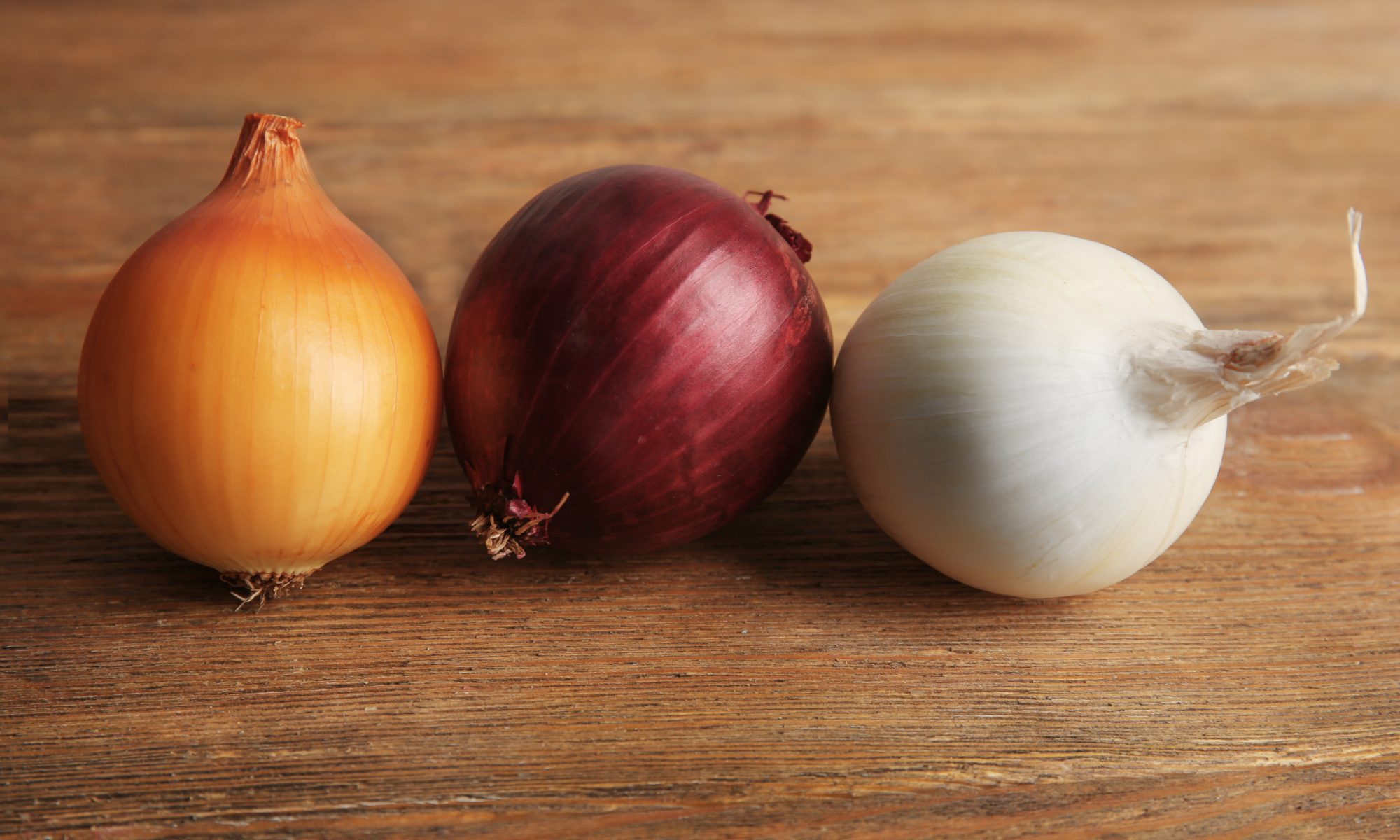Steven Rednikowski made a name for himself as a chef in Boulder, CO, with Oak at fourteenth. His new place in Denver, Acorn, is located in the 1880’s foundry that’s been converted to a high-end food court, or “epicurean marketplace” in Denver’s emerging hipster neighborhood, River North District. I found this place after doing some research on Denver’s burgeoning food scene, and Denver.eater.com put Acorn squarely in its “Essential Restaurant” listing, citing the eatery for its “hottest new American cuisine.”
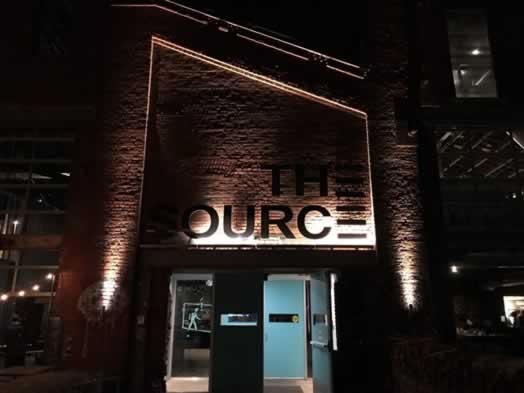
His website describes the style of food as “eclectic, contemporary American cooking in an approachable, family-friendly format.” The final phrase of that description, “family-friendly format,” is code for small plates, shared plates etc. And the food is fucking good!
Rednikowski is no overnight sensation. The resume – started in the business at 15 in a local pizzeria in Upstate New York, graduated to a culinary school in Schenectady, NY, moved to the City and landed a gig in 2000 at Le Cirque, followed by a stint at three Michelin-starred, Jean Georges. After that he moved west in 2002, first with a job at Little Nell in the iconic Aspen, CO, before taking an irresistible job in the Boulder, CO kitchen Frasca Food and Wine when Executive Chef and Co-Owner Lachlan Mackinnon-Patterson opened that restaurant. Staying in Colorado continuously was not in the cards at the time for Rednikowski. Instead, in 2006 he moved to Napa, CA to work under Chef Douglas Keane at the two-Michelin-starred Cyrus restaurant, only to return to Aspen two years later for the Executive Sous Chef job at Little Nell Hotel.
Rednikowski had met his Acorn business partner, Bryan Dayton, when the two were paired up at Frasca in Boulder and Dayton was managing the bar. In 2010 the duo got their dream jobs as owners, when they opened Oak to rave reviews and critical acclaim. Central to their food concept was an oak-wood fired oven and grill – a kitchen tool that is prominently featured at Acorn, which opened in 2013.
To this diner, the nearly 4 years since opening Acorn has served Rednikowski and Dayton very well, as my visit to Acorn one warm night in early July was a flawless evening of eating and drinking.
Flying solo, I sat at the bar, of course. Yet before sitting I checked out the vast interior of the old Foundry. A Mexican restaurant is across the way from Acorn. Some guys that had success with a food truck made the switch to a full-service place. There’s a bar in the back of the building – lots of craft beer, as expected. Craft beer may be the only “boutique” industry in Colorado that is bigger than marijuana. There’s a butcher shop, wine bar, charcuterie store. There were also young people making some sort of ice cream sandwich toward the front the building when I was there.
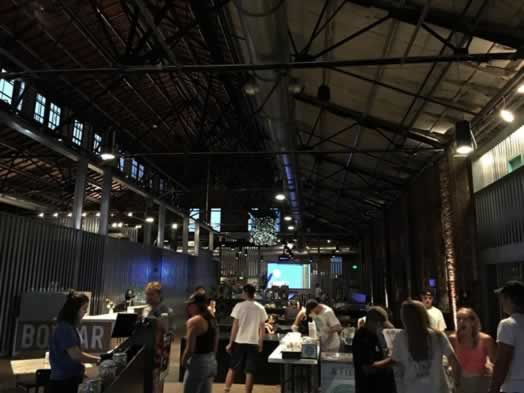
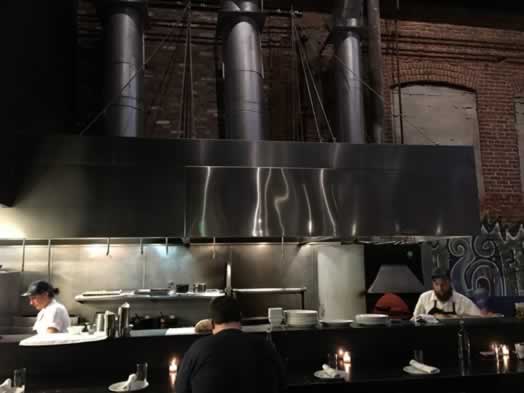
In keeping with the theme of ‘craft beer’ for more spirited types, the bar did not have the usual kind of vodkas I drink – mainstream brands. But it did have a locally made vodka that naturally caught my eye, called Woody Creek. The last place I lived in the Aspen area was a mostly finished solar house on 4 acres on Little Woody Week, and I was neighbors with the gonzo journalist, Hunter S. Thompson. I ordered the Woody Creek double on the rocks with a splash of soda, NFL – my new standard (No Fucking Lime, No Fucking Lemon). If the vodka is any good, let’s taste it!
From my seat at the bar, I looked past the bartenders to a little outdoor patio and a nice sunset right around 9 pm. This industrial zone is undergoing a lot of construction – mostly loft-style apartments. This is a new hotel being built next to the Source.

The night I was there, Acorn offered 18 small plate dishes. Immediately, I recognized the problem with dining alone at a place like this – I would only be able to sample 3 or 4 of these yummy nibbles. One item fairly leapt at me off the menu, which I knew I would start with, whereas I studied the rest of the menu over my cocktail, using the process of elimination to decide what might be my second, third, and fourth (if I had room) plates for dinner.
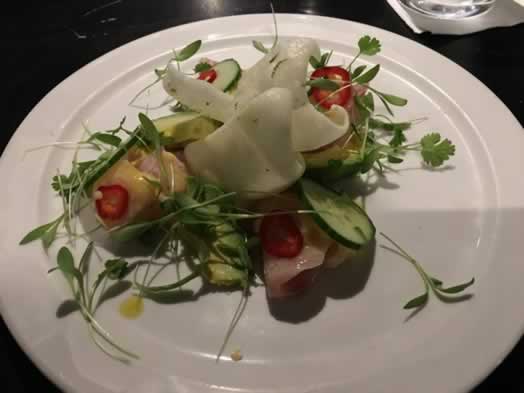
I started with the Hamachi Crudo (Hamachi Crudo – passion fruit vinaigrette, avocado, cucumber, Fresno pepper, cilantro), with a second cocktail. The cold vodka paired well with this dish, which was perfect in so many ways. The fish was very fresh, avo just right, acidity and snap from the Fresno chili in complete harmony – and the portion was amazingly generous. No skimping on core ingredients here. And for a California dude, the price of this dish, at $14, was difficult to get over. Back home in San Francisco, this plate would have easily sold for $26, maybe $28.
Noshing on the crudo, I “eliminated” the Key West royal red ‘shrimp & grits’, the oak smoked pork posole, the smoked trout sandwich, the smoked brisket sandwich (on a brioche bun) and the buttermilk fried chicken sandwich. I was really tormented by not ordering the crispy Icelandic cod, which looked as if it was prepared with Vietnamese influence, my favorite flavors (nuoc cham, napa cabbage, toasted peanuts, mint, cucumbers).
And I’m still made at myself for not starting with the crispy fried pickles with green goddess aioli. For $5, and no doubt delicious with vodka & soda, I could not have gone wrong. How often in life will you get a chance to eat a crispy fried pickle? Plus I would have had some insight as to what was to come with Chef Red’s food – cucumbers and its cousin, pickles. They appeared frequently, usually unexpectedly.
So for the second plate, I went with a vegetarian dish, grilled eggplant.
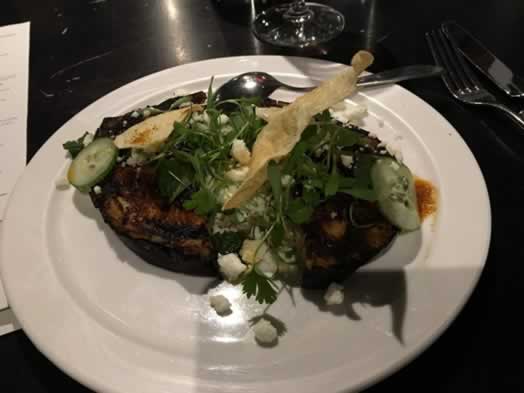
It was out of sight, as we used to say in the groovy years.
(Oak roasted eggplant – quinoa & Kalamata olive salad, chermoula, goat feta, tzatziki, papadum)
The eggplant was meaty, slightly smoky and perfectly grilled. It actually ate like a steak, and for my first few bites that’s what I focused on. And who knew, that pickle chips would contrast so nicely with grilled eggplant, not to mention the crispy Papadum crackers from the Indian subcontinent. This was all good, but the real wow factor came into play when I got below the eggplant to the quinoa with Kalamata olive oil, the tzatziki (yogurt-based) and the slightly creamy goat feta, which was accented by the Chermoula (the reddish sauce to the right of the plate), a slightly tangy marinade typically used by cooks in Algeria, Libya, Morocco and Tunisia. The chilled rose (Gerard Boulay, a Sancerre Rose from the Loire Valley, $12) I drank with this dish was as good a complement as Bonnie Parker was to Clyde Barrow, though I was optimistic that my story would not end as badly as theirs did.
By the time I finished the second plate, I had decided that the past hour or so was one of the most pleasurable 60 minutes of the year so far, with over 5 months to go!
While my appetite may have been sated with these first two courses, I was hungry for more. And I could not pass up the braised lamb, since braising meat is probably my favorite way to eat pork (shoulder/butt), beef (ribs) and lamb, especially in winter when you can pair these foods with creamy polenta, risotto and mashed potatoes.
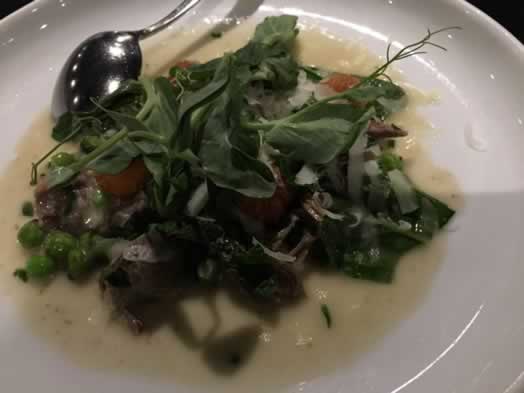
This dish was good – solid from start to finish, with a light and tasty sauce (from the melted ricotta) that called for a piece of bread to sop up (the bartender gladly obliged, bringing a side a toast though I only used half a slice). The lamb was tender, as expected, and the peas very fresh – as if it were still Spring and I was, in fact, in England. I drank a Terrazas Malbec, $15 from Mendoza, Argentina, thus proving that one can survive a great meal without a single California wine.
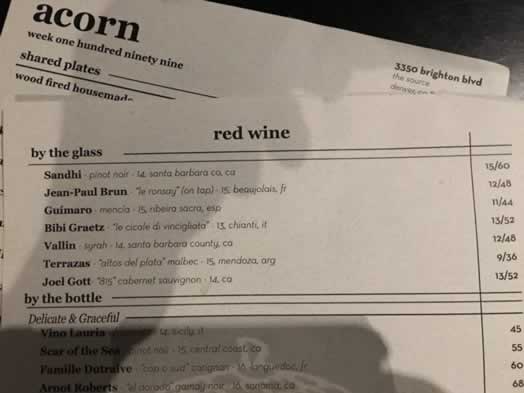
The lamb dish was delicious, though not as distinctive as my first two plates.
I might have ordered a fourth dish but I had an early morning with a train to catch for Aspen by 8 o’clock. As my 90+ year old father still says, “the best exercise you can do to keep the weight off is push yourself away from the table.”
And so I did, vowing to come back to Denver or better yet, go up to Boulder to eat Chef Rednikowski’s food again.
